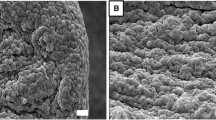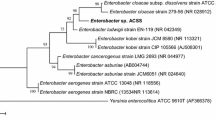Abstract
Saccharomyces cerevisiae CY phytase-producing cells were immobilized in calcium alginate beads and used for the degradation of phylate. The maximum activity and immobilization yield of the immobilized phytase reached 280 mU/g-bead and 43%, respectively. The optimal pH of the immobilized cell phytase was not different from that of the free cells. However, the optimum temperature for the immobilized phytase was 50°C, which was 10°C higher than that of the free cells; pH and thermal stability were enhanced as a consequence of immobilization. Using the immobilized phytase, phytate was degraded in a stirred tank bioreactor. Phytate degradation, both in a buffer solution and in soybean-curd whey mixture, showed very similar trends. At an enzyme dosage of 93.9 mU/g-phytate, half of the phytate was degraded after 1 h of hydrolysis. The operational stability of the immobilized beads was examined with repeated batchwise operations. Based on 50% conversion of the phytate and five times of reuse of the immobilized beads, the specific degradation (g phytate/g dry cell weight) for the immobilized phytase increased 170% compared to that of the free phytase.
Similar content being viewed by others
References
Reddy, N. R., S. K. Sathe, and D. K. Salunkhe (1982) Phytates in legumes and cereals.Adv. Food Res. 28: 1–92.
Wodzinski, R. J. and A. H. J. Ullah (1996) Phytase.Adv. Appl. Microbiol. 42: 263–302.
Martinez, C., G. Ros, M. J. Periago, G. Lopez, J. Ortuno, and F. Rincon (1996) Phytic acid in human nutrition.Food Sci. Technol. Int. 2: 201–209.
Potter, S. M. (1995) Overview of proposed mechanisms for the hypocholesterolemic effect of soy.J. Nutr. 125: 606S-611S.
Shamsuddin, A. M. (1995) Inositol phosphates have novel anticancer function.J. Nutr. 125: 725S-732S.
Raboy, V. (2001) Seeds for a better future: “low phytate” grains help to overcome malnutrition and reduce pollution.Trends Plant Sci. 6: 458–462.
Pandey, A., G. Szakacs, C. R. Soccol, J. A. Rodriguez-Leon, and V. T. Soccol (2001) Production, purification and properties of microbial phytases.Bioresour. Technol. 77: 203–214.
Ryu, S. and T. G. Park (1998) Thermal stabilization ofAspergillus phytase by L-arginine.Biotechnol. Bioprocess Eng. 3: 32–34.
Gibson, D. M. and A. H. J. Ullah (1988) Purification and characterization of phytase from cotyledons of germinating soybean seeds.Arch. Biochem. Biophys. 260: 503–513.
Simon, O. and F. Igbasan (2002)In vitro properties of phytase from various microbial origins.Int. J. Food Sci. Technol. 37: 813–822.
Mo, A.-Y., S.-M. Park, Y.-S. Kim, M.-S. Yang, and D.-H. Kim (2005) Expression of fungal phytase on the cell surface ofSaccharomyces cerevisiae.Biotechnol. Bioprocess Eng. 10: 576–581.
Seo, S.-W., M.-J. In, and N.-S. Oh (2005) Production and reaction properties of phytase bySaccharomyces cerevisiae CY strain.J. Kor. Soc. Appl. Biol. Chem. 48: 228–232.
Fraser, J. E. and G. F. Bickerstaff (1997) Entrapment in calcium alginate. pp. 61–66. In: G. F. Bickerstaff (ed.).Immobilization of Enzymes and Cells. Humana Press. Totowa, NJ, USA.
Fernandez-Lafuente, R., C. M. Rosell, V. Rodriguez, and J. M. Guisan (1995) Strategies for enzyme stabilization by intramolecular crosslinking with bifunctional reagents.Enzyme Microb. Technol. 17: 517–523.
Quan, C. S., S. D. Fan, and Y. Ohta (2003) Immobilization ofCandida krusei cells producing phytase in alginate gel beads: an application of the preparation ofmyo-inositol phosphates.Appl. Microbiol. Biotechnol. 62: 41–47.
Heinonen, J. K. and R. J. Lahti (1981) A new and convenient colorimetric determination of inorganic orthophosphate and its application to the assay of inorganic phosphatase.Anal. Biochem. 113: 313–317.
Latta, M. and M. Eskin (1980) A simple and rapid colorimetric method for phytate determination.J. Agric. Food Chem. 28: 1313–1315.
Cheetham, P. S. J., K. W. Blunt, and C. Bucke (1979) Physical studies on cell immobilization using calcium alginate gels.Biotechnol. Bioeng. 21: 2155–2168.
Greiner, R. and U. Konietzny (1996) Construction of a bioreactor to produce special breakdown products of phytate.J. Biotechnol. 48: 153–159.
Liu, B. L., C. H. Jong, and Y. M. Tzeng (1999) Effect of immobilization on pH and thermal stability ofAspergillus ficuum phytase.Enzyme Microb. Technol. 25: 517–521.
Ishiguro, T., T. Ono, K. Nakasato, C. Tsukamoto, and S. Shimada (2003) Rapid measurement of phytate in raw soymilk by mid-infrared spectroscopy.Biosci. Biotechnol. Biochem. 67: 752–757.
Lee, D. H., J. M. Kim, H. Y. Shin, S. W. Kang, and S. W. Kim (2006) Biodiesel production using a mixture of immobilizedRhizopus oryzae andCandida rugosa lipases.Biotechnol. Bioprocess Eng. 11: 522–525.
Arruda, L. M. O. and M. Vitolo (1999) Characterization of invertase entrapped into calcium alginate beads.Appl. Biochem. Biotechnol. 81: 23–33.
Author information
Authors and Affiliations
Corresponding author
Rights and permissions
About this article
Cite this article
In, MJ., Kim, KH. & Oh, NS. Phytate degradation by immobilizedSaccharomyces cerevisiae phytase in soybean-curd whey. Biotechnol. Bioprocess Eng. 12, 348–353 (2007). https://doi.org/10.1007/BF02931055
Received:
Accepted:
Issue Date:
DOI: https://doi.org/10.1007/BF02931055




